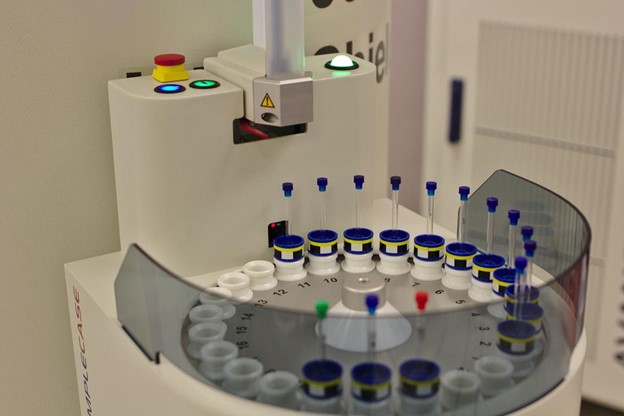Let’s dive into the fascinating world of lab vials!
These little containers might seem simple, but there’s more to them than meets the eye. Vials come in all shapes and sizes. Each is designed for specific experiments and substances.
From the common screw-top vial to the sophisticated lyophilization vial, each type has a story to tell. Let’s unravel the mystery behind these microscopic marvels. We will reveal how they make science happen!
Screw-Cap Vials
The Screw-Cap Vial is known for its ease of use and secure sealing feature. These vials are made of borosilicate glass or clear plastic. Each material caters to different experimental needs.
These are often the go-to choices for chromatography. This is because of their excellent thermal resistance and chemical compatibility.
Their reliable sealing mechanism prevents leakage and contamination. This makes them ideal for storing liquid and solid samples in lab experimentation.
Apart from chromatography, these vials’ applications span across the following:
– spectrophotometry
– cell culture
– microbial culture,
These are testifying to their versatility in the realm of scientific research.
Snap-Cap Vials
Snap-cap vials are another common type of lab vial, designed with a unique cap style that ‘snaps’ into place. This design provides an effective seal.
This is while still allowing the vials to be easily opened and closed. This makes them particularly handy for routine lab work.
These are made from glass or plastic. Snap-Cap Vials are often used in chromatography for their easy access and handling. They are particularly popular in DNA and RNA extraction processes.
This is due to the ability to retrieve small samples. This is without the risk of cross-contamination.
These vials are indispensable lab experimentation tools. This is with applications that reach far beyond the realm of chromatography. It highlights their utility and flexibility in various scientific endeavors.
Crimp-Top Vials
Crimp-top vials are among the most secure forms of lab vials. They are primarily used when a tight seal is paramount to the experiment’s success.
The cap uses a specialized tool that crimps or seals, the cap onto the vial. This ensures minimal risk of leakage or contamination.
These vials are employed in gas chromatography due to their airtight seals. These are crucial for maintaining the integrity of gas samples.
Made from glass, they are also resistant to thermal changes and chemical reactions. This makes them an essential lab experimentation tool.
Their vial applications are broad. They cover various laboratory processes including high-performance liquid chromatography (HPLC). It also includes other tasks requiring secure storage of samples.
Lyophilization Vials
Lyophilization Vials are for the process of freeze-drying. This is a method used to dehydrate fragile and heat-sensitive materials. This includes biological substances and pharmaceuticals.
These vials are specially engineered to withstand sub-zero temperatures. These also withstand the intense pressures of the lyophilization process. It preserves the integrity of the sample within.
These vials offer excellent thermal resistance and compatibility. This comes with a wide range of substances. Lyophilization Vials hold a unique place. This facilitates groundbreaking research and advancements in fields like:
– biotechnology
– medicine
– food technology
These vials are crucial for any experiment involving freeze-drying methodologies. This is when it comes to lab experimentation tools.
Autosampler Vials
These represent a key component in modern laboratory experimentation. This comes with a design tailored for automated sampling systems.
These vials are primarily used in chromatography. This is where precise and repeatable sampling is crucial.
Crafted from glass or plastic, these vials come with specific dimensions. This is to ensure compatibility with an array of autosampler devices. Their screw-cap, snap-cap, or crimp-top closures offer reliable sealing options.
These prevent sample contamination and leakage. This, thereby maintains the integrity of the sample for subsequent analysis.
These are a cornerstone in the field of automated laboratory testing. This is given their specific design and application. This contributes to efficiency and accuracy in scientific investigations.
Microsampling Vials
Microsampling Vials are experiments requiring small sample sizes. These vials are efficient in conserving precious samples in laboratory settings. These are often crafted from high-quality glass or plastic.
Their compact size makes them suitable for sensitive analyses like chromatography. This is where the accurate handling of minuscule sample volumes is vital.
Microsampling Vials have become instrumental in biomedical research, environmental testing, and forensic science. These allow scientists to conduct precise testing with limited sample volumes.
Shell Vials
Shell Vials are an essential lab tool. This is particularly designed for high-throughput screening and micro-volume sampling.
These vials permit easy access to the sample material. This makes them a preferred choice for microbiology, high-throughput screening, and cryogenic storage.
Shell Vials, made from glass or plastic, offer high chemical resistance. This makes them suitable for various types of chromatography. It is also suitable for other sensitive lab experiments.
These vials can store sufficient sample volumes for most applications. This is despite their compact size. This further broadens their utility in scientific research.
Dilution Vials
Dilution Vials play a crucial role in scientific labs. This is especially true in those processes where sample concentration needs to be accurately adjusted.
These vials are designed and used for diluting solutions or substances. This ensures precise and controlled reduction in sample concentration.
The vials are typically manufactured from glass or plastic. Both materials are known for their chemical resistance and durability.
They usually come with a screw-cap or snap-cap, providing a secure seal to avoid contamination and leakage. Notably, Dilution Vials are indispensable in the following:
- chemical analysis
- pharmaceutical testing
- microbiology
These underly their importance in the world of scientific research.
Explore The Different Types of Lab Vials
So, we’ve gone on a journey through the world of lab vials. Bet you didn’t know there were so many types, huh? Each one has its superpowers, from staying strong under extreme temperature changes to keeping tiny samples safe.
They’re all pretty amazing in their way. Whether it’s for checking out the teeny tiny details in a DNA sample or freeze-drying something for research, these vials are a scientist’s best friend.
So next time you walk past a lab or watch a cool science show, remember these little heroes helping us make big discoveries!
If you want to explore the best topics, we’ve got you covered. Check out some of our other blogs today!
Read Also
- How to Drive Growth Through Customer Centricity in HealthcareThe world of healthcare is changing in big ways. Consumers are now stepping up and taking charge of their health journeys. This change is happening now for important reasons. The U.S. health and wellness market is huge, projected to be over $6 trillion in 2025. This growth is fueled by rising out-of-pocket costs and more… Read more: How to Drive Growth Through Customer Centricity in Healthcare
- Maximizing Digital Reach for Podiatry Clinics in Local HealthcareMaximizing Digital Reach for Podiatry Clinics in Local Healthcare As the healthcare industry evolves, mobile marketing becomes indispensable for practitioners. Podiatry clinics, focusing on foot and ankle care, must adapt to digital strategies to engage patients effectively. Implementing tailored SEO practices is crucial for these clinics to thrive in an increasingly competitive market. Digital marketing… Read more: Maximizing Digital Reach for Podiatry Clinics in Local Healthcare
- Leveraging Virtual Medical Assistants to Maximize Operational Efficiency in HealthcareIn the increasingly complex and fast-paced world of healthcare, operational efficiency is critical. Doctors and healthcare administrators are faced with numerous challenges, from managing patient scheduling and medical billing to adhering to stringent regulatory compliance and insurance claims processing. These tasks, while essential, often divert time and resources away from the core mission of providing… Read more: Leveraging Virtual Medical Assistants to Maximize Operational Efficiency in Healthcare
- Optimizing CT Protocols: The Hidden Key to Efficiency and Cost Savings in RadiologyIntroduction: Why CT Protocol Optimization Matters Computed Tomography (CT) is a cornerstone of modern diagnostic imaging, providing critical information across nearly every medical specialty. However, maximizing the value of CT — both clinically and financially — requires more than just advanced hardware. The real secret lies in the optimization of CT protocols. When CT protocols… Read more: Optimizing CT Protocols: The Hidden Key to Efficiency and Cost Savings in Radiology
- Hospital Discharge Accuracy Improves With Daily Advisor InvolvementThe hospital discharge process has a big effect on patient recovery, hospital efficiency, and finances. It requires careful planning and clear communication between team members to make sure patients get the right care when they leave the hospital. Having physician advisors involved at this stage can improve the discharge process by spotting problems that need… Read more: Hospital Discharge Accuracy Improves With Daily Advisor Involvement
- Understanding Clinical Trials: What to Learn and the RoadblocksClinical trials are research studies conducted to determine the efficacy of medical, surgical or behavioral interventions. They are the most commonly used way that researchers assess whether new treatments, drugs or medical devices are safe and effective for use in humans. There are strict protocols governing these studies, and all of this is done in such a… Read more: Understanding Clinical Trials: What to Learn and the Roadblocks
- The Patient’s Voice: 7 Ways to Improve TelehealthTelehealth has transformed how we access healthcare, making it more convenient and accessible than ever before. However, as this technology evolves, so does the need for improvement. Patient feedback is essential in shaping these telehealth experiences. It offers valuable insights into what works, what doesn’t, and how we can make virtual care even better. Currently,… Read more: The Patient’s Voice: 7 Ways to Improve Telehealth
- How to Overcome Healthcare Claim Denial Challenges and Increase RevenueTable of Content Understanding Major Challenges in Healthcare Claim Denial Management Financial Impact of Healthcare Claim Denials Optimizing the procedure Important Strategies for Managing and Resolving Denials Understanding Major Challenges in Healthcare Claim Denial Management Healthcare Claim Denials have become a major challenge for healthcare providers and administrators. Such denials not only delay payments but… Read more: How to Overcome Healthcare Claim Denial Challenges and Increase Revenue









